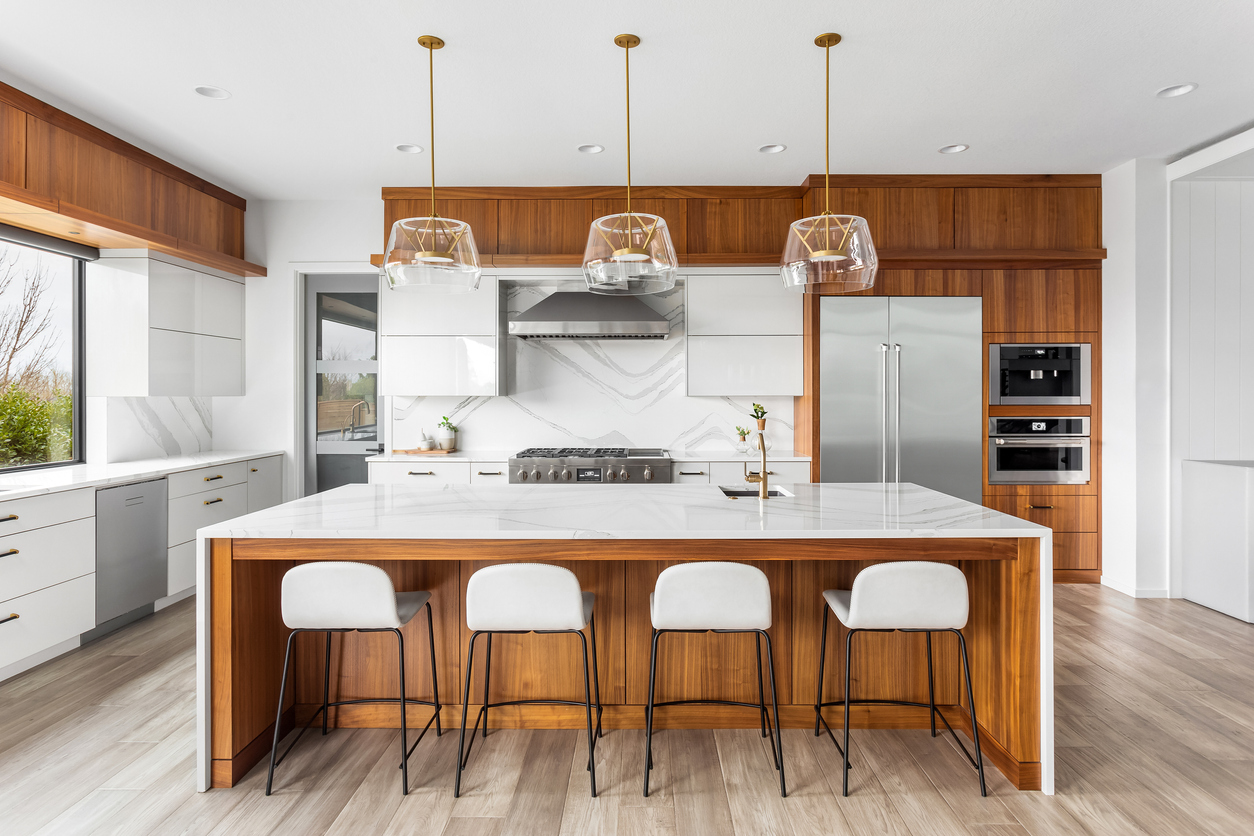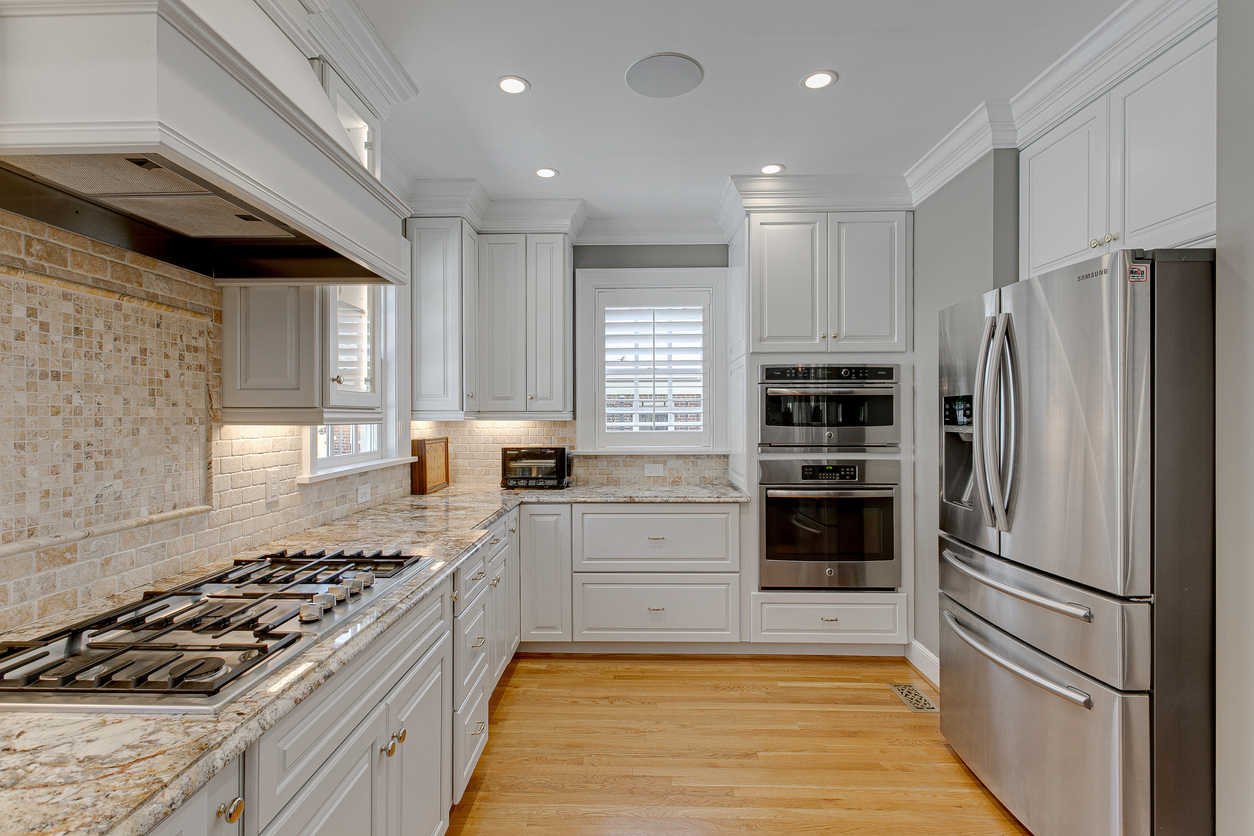We may earn revenue from the products available on this page and participate in affiliate programs. Learn More ›
When installing new kitchen cabinets, it’s important to consider what they’re made of. Some custom cabinets may be made entirely out of solid wood, but in most cases, the cabinet boxes, including the back, sides, top, and bottom, will be made out of plywood, MDF, or a similar material. These sheet goods are lighter in weight, lower in cost, and have a higher resistance to warping compared to solid wood.
However, visible parts like the cabinet doors, face frames, and trim are often made from solid wood because of its superior aesthetics. Solid wood is cut from trees and does not include any additives like resins or glue. Plywood is made up of a series of thin wood sheets, known as plies, that are arranged in a cross-grain pattern before being glued and pressed to make a complete panel. Use this guide to learn more about the difference between plywood and solid wood kitchen cabinets.
Stability

Before you buy kitchen cabinets, know that both plywood and solid wood are highly durable materials that can hold a significant amount of weight without bending or breaking.
Solid wood is an attractive, natural material that displays character through variation in grain patterns and density. However, this unique makeup can also affect the overall consistency and stability of the material. Temperature fluctuations can cause the wood to expand and contract, changing the shape of the cabinetry.
Plywood doesn’t share these issues. The layered design is better able to react to changes in the temperature, reducing the risk of expansion and contraction. Additionally, plywood is manufactured to be consistent in terms of strength, so homeowners know what to expect when they invest in plywood kitchen cabinets.
Paying a visit to your local home improvement store to see and touch cabinets made with solid wood and cabinets made with plywood can help determine your preference.
Moisture Resistance

When deciding between plywood and solid wood cabinets, it’s a good idea to consider where you live and the typical humidity levels in the area. Plywood cabinets are designed to absorb a small amount of moisture without bending or warping, though it can still be susceptible to water damage over a prolonged period.
Solid wood is especially prone to moisture problems. The porous nature of the wood allows it to absorb a significant amount of moisture, leading to bending, warping, and even cracking. When it comes to moisture resistance, plywood cabinets are the best kitchen cabinet option, though it’s still worth applying a sealant to further prevent any staining or swelling.
Installation

DIY kitchen cabinet installation is possible, though it’s not the easiest solo job due to the weight of the material and the difficulty of properly leveling the cabinet boxes. Plywood cabinets weigh less than solid wood, making them easier to hold during installation.
It’s recommended to hire a professional cabinet installer if you are working with a large section of cabinets. One of the main benefits to hiring a pro, according to Ryan Ehrlich, chief estimator at Paintworks & Decorating, is to “ensure the cabinets are installed properly and level.” Ehrlich also notes that DIY installation could lead to “cabinets [that are] not installed level, misaligned hinges, uneven doors or drawers, or cabinets falling.”
Appearance

Cabinets can take up a lot of room in a kitchen, so it’s important to find a kitchen cabinet style that suits your personal preferences. Plywood edges can stand out from the rest of the kitchen decor, but the material can be engineered to specific thicknesses and strengths, offering a high level of customization.
Solid wood is generally the superior material when it comes to appearance. There are many wood types to choose from, and each has a unique grain pattern that can add charm to your decor scheme. Homeowners can even invest in high-end wood like cherry or mahogany for an elevated look.
Sustainability

Both plywood and solid wood come from trees and are considered to be relatively sustainable materials, provided that the wood is harvested responsibly to maintain an ecological balance. Plywood makes use of wood from a variety of tree species. It’s also made up of smaller pieces of wood, allowing the manufacturer to utilize more of the harvested wood and reduce the overall waste.
Keep in mind that some high-end types of solid wood are not as easy to source. Harvesting these trees can cause significant environmental impact.
Maintenance

After installing new kitchen cabinets, you’ll need to keep up with regular maintenance to avoid any future problems. This includes cleaning the cabinets, making repairs, and sealing the wood. Plywood is more resistant to moisture and temperature changes than solid wood, so it won’t need to be resealed as frequently. Solid wood will need to be sealed or waxed to make the wood waterproof about once a year, depending on the average level of humidity.
Cost

The cost of kitchen cabinets is a key factor to consider if you are on a tight budget. Generally, plywood is a more affordable choice. Plywood cabinets will typically cost about $300 per linear foot, while the average cost of solid wood cabinets ranges from $300 to $400 per linear foot. However, if you choose an expensive type of wood, like cherry, maple, mahogany, or red oak, then the cost can increase to $500 or more per linear foot.
Some costs may differ depending on where the home is located. For instance, some tree species are more common on the East Coast than they are on the West Coast, making them easier and more affordable for homeowners to source in that region. Since plywood is made using a variety of readily available tree species, the cost is mostly uniform across the country.


